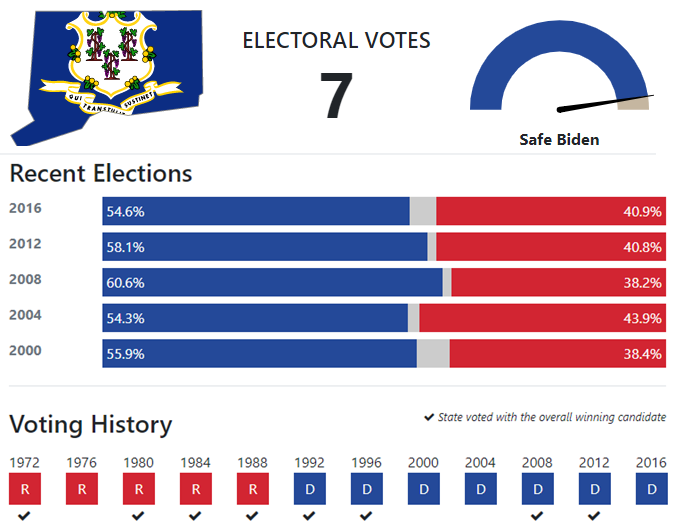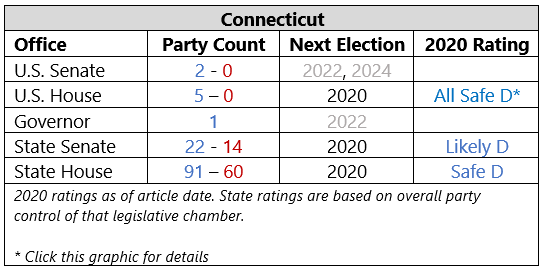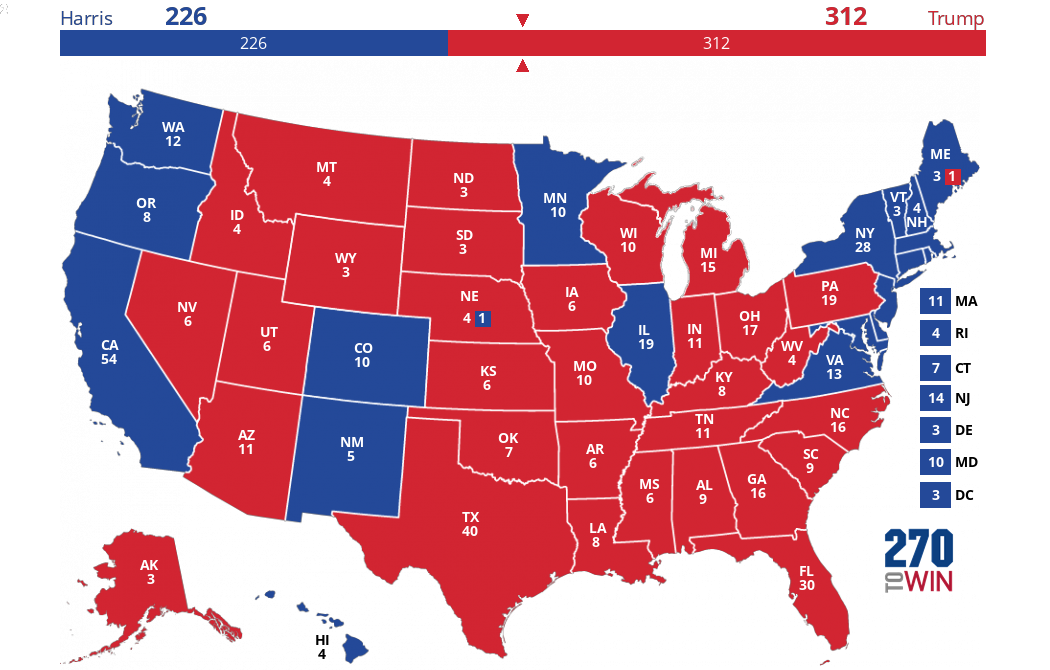The Road to 270: Connecticut
By Drew Savicki
April 27, 2020
Editor's Note: We're pleased to welcome Drew Savicki, who is taking over The Road to 270 beginning this week. Drew kicks things off with Connecticut, his state of birth. Special thanks to Seth Moskowitz for his work bringing this series to life; we wish him well as he moves on to a new career opportunity.
===
The Road to 270 is a weekly column leading up to the presidential election. Each installment is dedicated to understanding one state’s political landscape and how that might influence which party will win its electoral votes in 2020. We’ll do these roughly in order of expected competitiveness, moving toward the most intensely contested battlegrounds as election day nears.
The Road to 270 will be published every Monday. The column is written by Drew Savicki, a 270toWin elections and politics contributor. Contact Drew via email or on Twitter @DrewSav.
Connecticut
One of the 13 original colonies, Connecticut ratified the Constitution in January, 1788. It is one of seven states1 1The others are Delaware, Massachusetts, Maryland, New Hampshire, New Jersey and Pennsylvania. that has participated in all 58 presidential elections. Few states have influenced the United States’ electoral process more than Connecticut.
At the 1787 Constitutional Convention in Philadelphia, a hotly-debated topic was the composition of the nation’s legislative branch. The Framers hailing from larger states, like Virginia, preferred a legislature with seats apportioned based on population, while members from smaller states favored equal representation across the board. Connecticut’s delegates to the convention, Roger Sherman and Oliver Marshall, offered the Great Compromise -- in a bicameral legislature, each state would have equal representation in the upper house while seats in the lower house would be distributed based on population. Today, each state’s clout in the Electoral College is based on that congressional apportionment.
From mills to mavericks
A century ago, Connecticut was known for its Yankee brand of Republicanism. It favored Republicans for much of the early twentieth century, though the split in the national GOP allowed Democrat Woodrow Wilson to squeak out a 39% plurality in the state during the 1912 election. Even in the watershed 1932 election, it stuck with the unpopular Republican Herbert Hoover over Democratic challenger Franklin Roosevelt, although by just one percentage point.
Once in office, Roosevelt’s New Deal programs brought new voters, who were often first- or second-generation Americans, into the political process. In a Connecticut context, white ethnics -- such as Irish, Italians, and Poles -- who migrated to work in the state’s mill towns, began voting, and for Democratic candidates. These groups were predominantly Catholic or Jewish, and changed the state’s Protestant Republican image. This set the stage for another defining election: 1960.
John F. Kennedy's 54%-46% win in the Nutmeg State was significant in that it gave Democrats a foothold there. Still, the realignment that produced the Connecticut that we know today has its roots in the 1980s. 1988 was an especially pivotal election; then-Vice President George Bush carried the state by five percentage points. This was a concerning result for Republicans on several levels. First, given that Bush won nationally in a 426 Electoral Vote landslide, his 52%-47% edge there seemed underwhelming. Further, he had deep personal connections to the state -- his father, Prescott Bush, represented the state in the Senate from 1952 to 1963.
Perhaps a third sign of weakness for Bush in Connecticut was that the 1988 Senate result there fed into the narrative that his presidential victory was a ‘lonely landslide.’ Of the 33 states that held Senate elections that year, some 14 voted for Bush but elected Democratic Senate candidates -- Connecticut was one of them. The 1988 Senate election was among the most fascinating in the state’s history; it featured two of its most consequential politicians, both of whom would been billed a ‘mavericks’ throughout the careers. Ultimately, then-state Attorney General Joe Lieberman (D) narrowly ousted Sen. Lowell Weicker (R-CT).
First elected in 1970, Weicker was long known for his independence: Serving on the Watergate Committee, he challenged his own party’s president and later became known for his quarrels with fellow Sen. Jesse Helms (R-NC), a darling of social conservatives. A rare Republican with appeal to labor, the state’s AFL-CIO endorsed him in 1988, while he ran with the slogan “Nobody’s man but yours.” In 1990, Weicker dropped his GOP affiliation and rebounded to win the gubernatorial race under the ‘A Connecticut Party’ label -- a third party that was strategically named so that it would appear first on the alphabetically-oriented ballot.
By the same token, in the 1988 race, Lieberman found support with typically-Republican constituencies. William Buckley, editor of the conservative National Review magazine, endorsed him. A tradition-minded Democrat favoring a hawkish foreign policy, Lieberman famously lost his 2006 Senate primary over his support for the Iraq War. Ironically, in a move reminiscent of Weicker, Lieberman ran as a third party candidate in the general election that year (the state is one of the few that lacks a sore loser law) -- he was reelected in large part because his 70% share of the Republican vote. Speaking to Lieberman’s political versatility, though he served as former Vice President’s Al Gore’s running mate in 2000, he was rumored to have been the late Sen. John McCain’s ideal VP choice for the 2008 Republican ticket.
Congressional politics
Since Lieberman’s 50%-49% victory in 1988, Democrats have largely continued their winning record in Connecticut Senate races -- while Lieberman was technically reelected as an independent in 2006, he continued to caucus with his old party. The state’s other seat was held by Chris Dodd (D-CT), a household name in the state from a political family, from 1981 until 2011. Dodd looked vulnerable going into the 2010 elections but ended up retiring. Democrats had a ready stand-in candidate that cycle with popular state Attorney General Richard Blumenthal.
Lieberman himself retired in 2012, and was replaced by Rep. Chris Murphy (D, CT-5). In their initial elections, in 2010 and 2012, respectively, both Blumenthal and Murphy faced the same GOP opponent: Linda McMahon, the wife of WWE wrestling magnate Vince McMahon. Both Democrats beat McMahon by the same 55%-43% margin.
In the House, Democrats have held all five of the state’s districts since 2009 -- its delegation weathered the red waves of 2010 and 2014 fairly comfortably. In past decades, its congressional elections were more susceptible to national tides. In 1956, as the state gave President Eisenhower a hefty 64%-36% vote in his reelection effort, it also sent an all-GOP delegation to the House. Two years later, a combination of foreign policy travails and domestic setbacks sent Ike’s approval on a downward trajectory -- when Connecticut voters went to polls in 1958, they elected only Democrats to the House.
As it stands today, Connecticut is a reliably blue, but polarized, state. A hub for the financial and health insurance industries, Democrats in the Nutmeg State are best served by keeping an ear to the business community.
A bit of geography
Before looking at the state’s recent electoral history, a bit of geography will be useful. Connecticut can be divided into five regions.
1) Hartford County - Central Connecticut. Anchored by the state capitol of Hartford and its surrounding suburbs, this area is racially diverse and home to a mixture of both upscale and blue collar whites.
2) Fairfield County - Southwestern Connecticut. This suburban county is the only one in the state that's growing and is also the most educated. In the Trump era, Democrats have made major gains here.
3) Tolland and Windham Counties - Northeastern Connecticut. These counties span from the Hartford suburbs to the more rural parts of the east.
4) New Haven County - Southern Connecticut. The city of New Haven anchors the county but some adjacent towns saw double-digit swings to Trump in 2016. Likely a problematic area for Democrats in the long term.
5) Middlesex and New London Counties - Southeastern Connecticut. These are liberal coastal communities but the more inland parts of the counties lean Republican.
State level politics
Like much of New England, Connecticut voters will consider supporting local Republicans. Republicans controlled the governorship from 1995 to 2011 and the three most recent gubernatorial elections have all been within five percentage points. Still, Democrats have maintained control of all row offices since 1999 and the legislature has consistently remained in Democratic hands. Unlike their counterparts in neighboring states, though, Connecticut Democrats lack supermajorities in either chamber -- some vestiges of the old Yankee GOP coalition can still be seen at the local level.
Gov. Ned Lamont (D-CT), was elected in 2018 despite the low approval ratings his predecessor, fellow Democrat Dan Malloy, sported for much of his tenure. In 2010, Lamont lost the Democratic primary to Malloy 57%-43%. Four years earlier, he upset Lieberman in that 2006 Senate primary, only to lose the general election 50%-40% to an independent Lieberman.
In his third attempt at statewide office in 2018, Lamont may have caught a break when President Trump weighed into the race with an endorsement of the GOP nominee, Bob Stefanowski. Trump’s support likely helped nationalize the race in way that, ironically, hurt Republicans.
What's good for Trump
Though one of the nation’s most well-educated states, 39% of Connecticut's residents lack a college degree. These working class voters can be found in former industrial towns that dot the landscape in northwestern and east. Trump ran particularly well in eastern towns near the Rhode Island border. Mitt Romney, a wealthy businessman, proved a poor fit for these voters but Trump's cultural conservatism seemed to catch on. In addition, a handful of Democratic legislators hold districts that Trump carried -- his presence atop the ballot again will be welcomed by some local Republican candidates. Redistricting in Connecticut requires 2/3 supermajorities in both chambers, which Democrats currently lack.
Recent elections
Since 1992, every Democratic presidential nominee has carried Connecticut. Bill Clinton’s 1992 and 1996 victories relied on the state's urban centers and he was perhaps aided by Ross Perot’s relatively strong showing in parts of the east; Perot carried four towns there in 1992, all of which favored Bush in 1988.
In 2000, Vice President Al Gore was not able to maintain Clinton's working support but traded it for increased support in Fairfield County. This exchange came despite the presence of Sen. Lieberman on the Democratic ticket that year. Lieberman was also up for reelection to the Senate that year -- though he didn’t win the Vice Presidency, he was reelected to the Senate with 63% and carried 40 towns that also went for George W. Bush further up the ballot.
Four years later Connecticut would shift to the right again, as Bush enjoyed higher approval ratings in the northeast, due to 9/11. By 2006, though, opposition to the Bush Administration fueled the defeats of Reps. Nancy Johnson (R, CT-5) and Rob Simmons (R, CT-2). State Senator Chris Murphy (D) hammered Johnson over her support for Medicare Part D and tied her to the unpopular national GOP. In one of the cycle’s closest races, Simmons lost his seat by an 83-vote margin.
Barack Obama carried the Nutmeg state by an impressive 22% in 2008, while sweeping its eight counties. Long a hub for the financial industry, Connecticut was particularly hurt by the onset of the Great Recession. Obama's coattails were enough to lift businessman Jim Himes (D) to victory over longtime Rep. Chris Shays (R, CT-4) in the Fairfield County-based district. Shays was likely in a tough position regardless, but seemed to downplay the country’s growing economic woes -- surely a factor in his defeat. With Himes’ victory, Democrats had clinched all the state’s congressional seats for the first time since the Lyndon Johnson presidency.
In 2012, Obama carried the state by a reduced margin, but it was still a wide 58%-41% vote. GOP nominee Mitt Romney flipped a county -- Litchfield, in the rural northwestern part of the state -- but overall, 2012 was a year of stability.
2016, though, was a realigning election in Connecticut. Hillary Clinton carried the state 55%-41% but bled rural support. In a sign of the increasing urban/rural rift, Trump was the first Republican nominee since George H. W. Bush, in 1988, to carry a majority of the state’s towns – Trump won in 88 of its 169. Still, in Fairfield County, Clinton flipped the wealthy towns of Darien and New Canaan, becoming the first Democratic nominee since Lyndon Johnson in 1964 to do so.
The changes seen in 2016 carried over to the 2018 elections. Of the four U.S. House members that ran for reelection, only Rep. Himes saw his margin increase from 2016. Though they each cleared 60% of the vote, veteran Reps. Rosa DeLauro (D, CT-3) and Joe Courtney (D, CT-2) saw their working class support drop -- for the first time since 2010, Courtney lost a town (Sterling, on the Rhode Island border).
All things considered, Connecticut’s seven electoral votes are safely in Joe Biden’s corner this November. With no competitive congressional districts to speak of either, Connecticut is unlikely to get much attention in the fall campaign.
Next Week: Alaska



